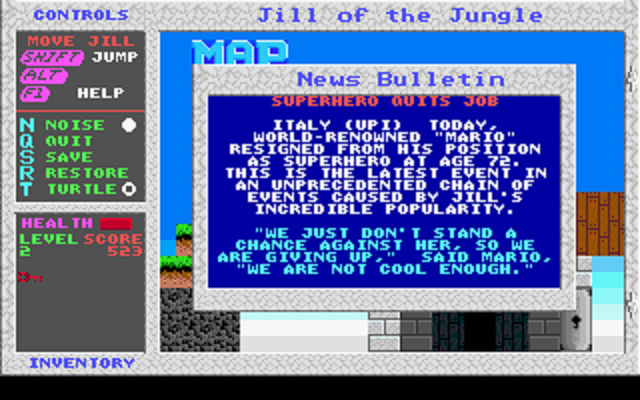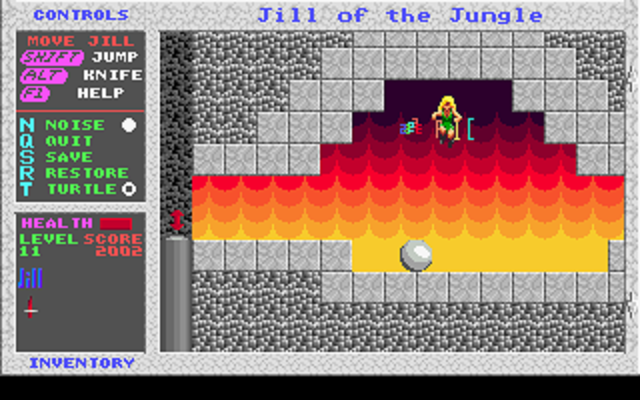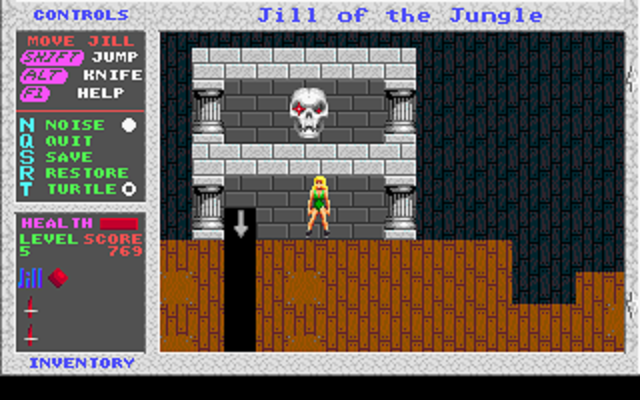Game Review: Jill of the Jungle
Some people played NES platformers, the Marios and Metroids and Castles vania that stride across platformer history like titans, and then moved on to the Genesis or the SNES and played Super Mario World, Sonic the Hedgehog, Super Metroid, Mega Man X, and Gunstar Heroes. Some of the greatest platformers ever made, games that still stand the test of time even decades later.
And some of us didn't have either of those consoles and ended up graduating to DOS platformers.

"Map" here is a relative term.
I'm pretty sure I first ended up playing Jill of the Jungle from one of those shareware CDs that were everywhere in the mid-90s, along with other games like Duke Nukem (back when it was a sidescrolling platformer), Cosmo's Cosmic Adventure, Ancients 1: Deathwatch, ZZT, Dare to Dream, One Must Fall 2097, Jazz Jackrabbit, Solar Winds, Thor's Hammer, some 3D dungeon crawl game I've ever been able to find again where it was a fantasy setting but all the enemies were giant ants, a 256-color tile-based graphical roguelike where the only thing I remember is picking a vampire who had the racial disadvantage that sometimes demons spawned and murdered you, and hundreds of other games I don't remember because they were terrible. Or I didn't like them. When you're a kid, those two categories kind of blend together.
But Jill of the Jungle actually stuck with me, to the point where I did the thing that you did when you could beat a platformer--I replayed it over and over trying to get higher scores. I've probably beaten it a dozen times before, and now that I have a game controller and Joy2Key so I could actually play it without using the awful keyboard controls that were the real downfall of most DOS platformers, I figured it deserved another time through. It took me about an hour and a half.

Wishful thinking.
One of the major differences between Jill of the Jungle and other contemporary platformers, even other DOS-based platformers, is the way it deals with defeat. There are no lives and the beginning of every level acts as a checkpoint, so it's just a matter of hurling yourself at the challenges until you succeed. That, in itself, isn't that remarkable, since something like Super Meat Boy works the same way. However, it also has a save/load system, and you can save and load at any time, even in the middle of a level. Even before every single jump. It effectively replicated modern emulators with savestates except as part of the base design. I appreciate it now, but I wonder if it lost something when you can save and load after every single challenge.
Though "challenge" is a bit of an overstatement. Very little in Jill of the Jungle is actually challenging at all, much less difficult. There are the classic platformer instant-killing hazards, like spikes, lava, water, and so on, a few animals that patrol back and forth in a set pattern, beehives that launch bees at you, and every once in a while, there's an enemy that changes things up a bit, like crabs that can climb ropes. But everything is predictable, almost nothing tries to attack you, and in general they're just targets set up that you knock down with the knives and spinning blades that Jill gets. The most dangerous enemy is the controls, which are pretty clunky and have none of the smoothness of the good early console platformers. Jill always moves in half-square or full-square chunks--you can see how the world is divided up into squares in the screenshots--and so it's really easy to move just too far and fall into a pit or off a platform. It's not that annoying, because you can just reload, but if you're saving after every jump, it's the equivalent of playing Doom and saving after killing every demon. It breaks up the flow and ruins the gameplay.
Also, look at that DOS platformer UI. Do you really need a constant reminder of what button to press?

They let you fly and then put you in here.
The main gimmick of Jill of the Jungle is the transformations into firebird, frog, and fish, but it's about as well implemented as it is in Trip World. First of all, there's none of the planning that Super Mario Brothers 3 or even Super Mario World offers with being able to choose which form you tackle a stage in. If you wanted to try to beat all of Super Mario Brothers 3 in the frog suit, you could, and indeed people have. Jill of the Jungle only lets you transform in specific areas and those are few and far between.
Firebird gets the most love, but even there, it's only in three of the thirteen stages and only for specific areas. Frog occurs once and just lets you jump higher so you can get up to a firebird transform, and seems pretty superfluous because there's a (stackable!) powerup that increases Jill's jumping height anyway. Fish also only occurs once, in a level filled with water, and seems to only exist because like a true action hero Jill dies instantly if she falls into water that rises higher than her waist. I understand that letting someone pick fish and go into a non-water level would be annoying, but picking frog would have been an interesting challenge. No attacks in exchange for higher jumping?
I guess it wouldn't have worked with the level structure, though. Once you enter a level there's no way to leave it, so they'd have to redo the whole powerup system. And they should redo the whole powerup system because it's not that great.

C-c-c-combo!
The best part of Jill of the Jungle for me is actually the sound. I went to the trouble of downloading all the level themes in mp3 from Youtube--my favorite is probably Dan, the track used for the castle maps--but even the sound effects are pretty neat. I can see how they would be annoying for some people, but I actually like the sproing sound when she jumps and the heavy thud when she lands. The heavy thud coupled with the slight pause on impact helps give her jumps a sense of weight, which, while it doesn't entirely make up for the clumsy controls, does help mitigate it a bit.
But other than that, Jill of the Jungle is a middling game that I primarily love due to nostalgia. With a bit more time in the oven, it could have been a pretty good platformer. And from poking around YouTube, it looks like the second and third games in the series have better implementations of some of these ideas, like better implementation of the transformations, more challenging enemies, and Jill of the Jungle 3 actually has an overworld instead of the "map" you can see in the first screenshot and enemies that don't all die in a single hit.

#doom
Those weren't shareware games, though, so it's perhaps understandable that Jill of the Jungle is a bit underbaked. I remember being incensed as a kid that the shareware version of Doom didn't have the plasma rifle or the BFG, but it makes sense. Reel them in with the shareware and then give them reasons to buy the full version. And I do have copies of Jill of the Jungle 2 and 3 now, so maybe after all these years I can give them a try without a patina of nostalgia to color my impressions.
Though really, Jill of the Jungle is pretty much exactly as I remember it. It's just that now, I've played all those 16-bit console platformers, so I know what I was missing.
And some of us didn't have either of those consoles and ended up graduating to DOS platformers.

"Map" here is a relative term.
I'm pretty sure I first ended up playing Jill of the Jungle from one of those shareware CDs that were everywhere in the mid-90s, along with other games like Duke Nukem (back when it was a sidescrolling platformer), Cosmo's Cosmic Adventure, Ancients 1: Deathwatch, ZZT, Dare to Dream, One Must Fall 2097, Jazz Jackrabbit, Solar Winds, Thor's Hammer, some 3D dungeon crawl game I've ever been able to find again where it was a fantasy setting but all the enemies were giant ants, a 256-color tile-based graphical roguelike where the only thing I remember is picking a vampire who had the racial disadvantage that sometimes demons spawned and murdered you, and hundreds of other games I don't remember because they were terrible. Or I didn't like them. When you're a kid, those two categories kind of blend together.
But Jill of the Jungle actually stuck with me, to the point where I did the thing that you did when you could beat a platformer--I replayed it over and over trying to get higher scores. I've probably beaten it a dozen times before, and now that I have a game controller and Joy2Key so I could actually play it without using the awful keyboard controls that were the real downfall of most DOS platformers, I figured it deserved another time through. It took me about an hour and a half.

Wishful thinking.
One of the major differences between Jill of the Jungle and other contemporary platformers, even other DOS-based platformers, is the way it deals with defeat. There are no lives and the beginning of every level acts as a checkpoint, so it's just a matter of hurling yourself at the challenges until you succeed. That, in itself, isn't that remarkable, since something like Super Meat Boy works the same way. However, it also has a save/load system, and you can save and load at any time, even in the middle of a level. Even before every single jump. It effectively replicated modern emulators with savestates except as part of the base design. I appreciate it now, but I wonder if it lost something when you can save and load after every single challenge.
Though "challenge" is a bit of an overstatement. Very little in Jill of the Jungle is actually challenging at all, much less difficult. There are the classic platformer instant-killing hazards, like spikes, lava, water, and so on, a few animals that patrol back and forth in a set pattern, beehives that launch bees at you, and every once in a while, there's an enemy that changes things up a bit, like crabs that can climb ropes. But everything is predictable, almost nothing tries to attack you, and in general they're just targets set up that you knock down with the knives and spinning blades that Jill gets. The most dangerous enemy is the controls, which are pretty clunky and have none of the smoothness of the good early console platformers. Jill always moves in half-square or full-square chunks--you can see how the world is divided up into squares in the screenshots--and so it's really easy to move just too far and fall into a pit or off a platform. It's not that annoying, because you can just reload, but if you're saving after every jump, it's the equivalent of playing Doom and saving after killing every demon. It breaks up the flow and ruins the gameplay.
Also, look at that DOS platformer UI. Do you really need a constant reminder of what button to press?

They let you fly and then put you in here.
The main gimmick of Jill of the Jungle is the transformations into firebird, frog, and fish, but it's about as well implemented as it is in Trip World. First of all, there's none of the planning that Super Mario Brothers 3 or even Super Mario World offers with being able to choose which form you tackle a stage in. If you wanted to try to beat all of Super Mario Brothers 3 in the frog suit, you could, and indeed people have. Jill of the Jungle only lets you transform in specific areas and those are few and far between.
Firebird gets the most love, but even there, it's only in three of the thirteen stages and only for specific areas. Frog occurs once and just lets you jump higher so you can get up to a firebird transform, and seems pretty superfluous because there's a (stackable!) powerup that increases Jill's jumping height anyway. Fish also only occurs once, in a level filled with water, and seems to only exist because like a true action hero Jill dies instantly if she falls into water that rises higher than her waist. I understand that letting someone pick fish and go into a non-water level would be annoying, but picking frog would have been an interesting challenge. No attacks in exchange for higher jumping?
I guess it wouldn't have worked with the level structure, though. Once you enter a level there's no way to leave it, so they'd have to redo the whole powerup system. And they should redo the whole powerup system because it's not that great.

C-c-c-combo!
The best part of Jill of the Jungle for me is actually the sound. I went to the trouble of downloading all the level themes in mp3 from Youtube--my favorite is probably Dan, the track used for the castle maps--but even the sound effects are pretty neat. I can see how they would be annoying for some people, but I actually like the sproing sound when she jumps and the heavy thud when she lands. The heavy thud coupled with the slight pause on impact helps give her jumps a sense of weight, which, while it doesn't entirely make up for the clumsy controls, does help mitigate it a bit.
But other than that, Jill of the Jungle is a middling game that I primarily love due to nostalgia. With a bit more time in the oven, it could have been a pretty good platformer. And from poking around YouTube, it looks like the second and third games in the series have better implementations of some of these ideas, like better implementation of the transformations, more challenging enemies, and Jill of the Jungle 3 actually has an overworld instead of the "map" you can see in the first screenshot and enemies that don't all die in a single hit.

#doom
Those weren't shareware games, though, so it's perhaps understandable that Jill of the Jungle is a bit underbaked. I remember being incensed as a kid that the shareware version of Doom didn't have the plasma rifle or the BFG, but it makes sense. Reel them in with the shareware and then give them reasons to buy the full version. And I do have copies of Jill of the Jungle 2 and 3 now, so maybe after all these years I can give them a try without a patina of nostalgia to color my impressions.
Though really, Jill of the Jungle is pretty much exactly as I remember it. It's just that now, I've played all those 16-bit console platformers, so I know what I was missing.